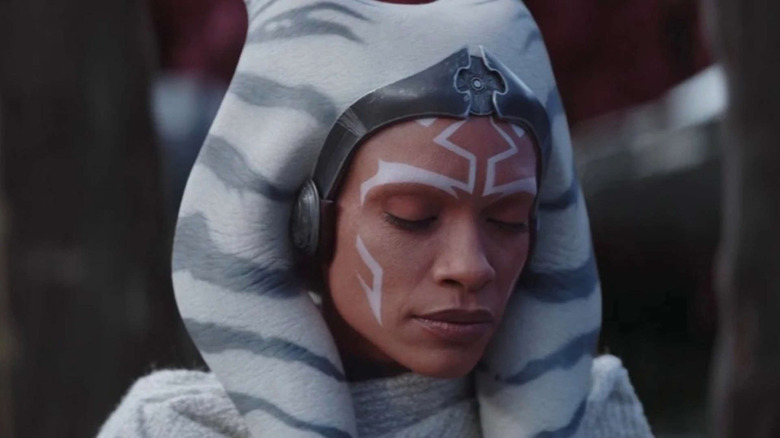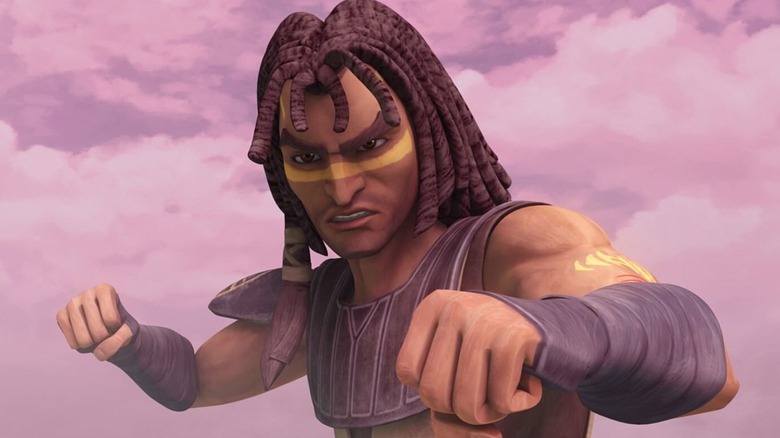Ahsoka Uses A Rare And Potentially Dangerous Jedi Force Power In Episode 5
This article contains spoilers for the latest episode of "Ahsoka."
Every time a character in a "Star Wars" show or film reveals a heretofore unknown Force-based ability, there's always going to be a contingency of viewers who find themselves turning into Han Solo and grumpily yelling, "That's not how the Force works!" Pretty much without fail, however, there's an earlier "Star Wars" project that's already established that this is, in fact, how the Force works. If anything, the last 46 years of "Star Wars" have taught us that the Force is often pretty darn weird, with this week's episode of "Ahsoka," "Shadow Warrior," providing yet another useful reminder of just that.
Upon returning from her near-death Force experience, the episode has Ahsoka Tano emerging from the oceans of Seatos and using the Force to read the history of the destroyed star map leading to Grand Admiral Thrawn. In doing so, she is able to determine exactly what happened to her missing Padawan, Sabine Wren.
For as much as it might seem like a convenient plot device, Ahsoka's Force trick here is known as psychometry and has a deep history in "Star Wars." Its first appearance was in the no-longer-canonical 1994 Legends/Expanded Universe novel "The Courtship of Princess Leia," in which Luke Skywalker tracked Han (who had basically kidnapped Leia Organa in an attempt to prevent her from marrying someone else) by using the Force to sense the emotional traces he had left at a casino on Coruscant. However, the term psychometry wasn't used to describe this ability until the Legends comic book run "Star Wars: Republic," published by Dark Horse from 1998 to 2006.
The dangers of psychometry
In terms of the current canon, psychometry first showed up in the "Star Wars: The Clone Wars" season 3 episode "Hunt for Ziro," in which the Jedi Master Quinlan Vos tracked Jabba the Hutt's uncle Ziro by using items like a cup he had drunken from or the ground he had recently touched. As you might imagine, his mastery in this area also made Vos a figure of controversy. The Jedi Council, in particular, was quite wary of this power, realizing it could potentially expose a Jedi to the dark side if used on an object with a history of terrible violence or some other ties to violent emotions. Turns out, they were right to be concerned.
During the video game "Star Wars Jedi: Fallen Order," the Jedi Cal Kestis gets his mitts on the lightsaber of the Jedi-hunting Inquisitor known as the Second Sister, only to find himself briefly paralyzed when he catches a glimpse at her disturbing past (back when she was a young Jedi who was captured and tortured into serving the Empire). Luckily, rather than attacking him while his guard is down, the Second Sister merely elects to flee.
Everyone's favorite Jakku scavenger turned Jedi Rey similarly had an unexpected vision of the dark history of Luke Skywalker's lightsaber upon grasping it in "Star Wars: Episode VII — The Force Awakens," much like she did while holding the Blade of Ochi (more commonly referred to as the Sith Dagger) during "Episode IX — The Rise of Skywalker." In both cases, the characters' unintentional use of psychometry could have gone very badly very quickly, had they been less fortunate.
More than just a plot device
There's something poetic, and thus, for lack of a better description, fundamentally "Star Wars" about the notion that individuals leave emotional marks on the items they come into contact with. As helpful as psychometry can be as a means of advancing the plot, the best "Star Wars" projects are the ones that use it for character development too. Such is the case in "The Force Awakens," as Rey's lightsaber vision leaves her understandably shaken and fearful of her ability to wield the Force despite having a powerful and immediate connection to it. That's not so much the case in "The Rise of Skywalker," where Rey's ability to "read" the history of the Sith Dagger functions as little more than a plot device.
Fortunately, both Ahsoka the character and the show around her know how to properly utilize psychometry in "Shadow Warrior." While reading the emotional traces left on the star map, Ahsoka not only discovers that Sabine willing gave up the object and allowed herself to be captured by the fallen Jedi Baylan Skoll, but she also learns her Padawan did so believing this would be her last shot at ever finding their long-lost comrade Ezra Bridger. Being able to fully empathize with Sabine and having only barely undergone her own intense emotional journey with her trip to the past, this will make it easier for Ahsoka to show Sabine the patience and understanding that she wasn't capable of upon originally taking her on as a student. Like Ahsoka's old master Anakin Skywalker tells her in the episode, "One is never too old to learn, Snips."
New episodes of "Ahsoka" premiere Tuesday evenings on Disney+.


